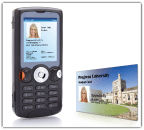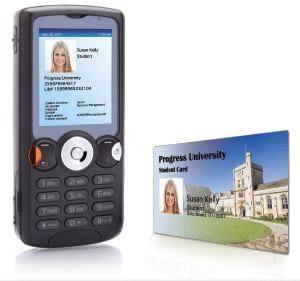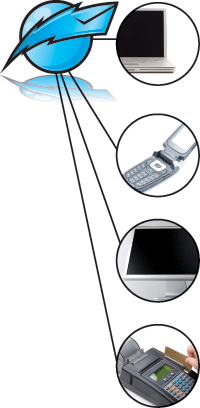 By Andy Williams, Contributing Editor
By Andy Williams, Contributing Editor
Providing campuses with the ability to instantly notify their students in the event of a disaster or emergency was on most campus card vendor’s to-do lists. But the Virginia Tech incident quickly moved what had been a mid-tier suggestion all the way to the top.
The deadliest shooting in U.S. history occurred April 16, 2007 when Seung-Hui Cho killed 32 people and wounded 25 others before killing himself on the campus of Virginia Tech in Blacksburg, Virginia. Since then, colleges around the country have been investigating ways that students, faculty and staff could have been notified quicker.
Tasked with the need to develop a system that can get emergency messages out quickly, campus card and other technology providers have been investigating what’s available and what needs to be done.
Since a cell phone today is like a third appendage to most students, the most obvious solution is an instant messaging service that would notify students within seconds of a possible disaster or “gunman on campus” type of scenario. Easier said then done, however. Not only do you need every student’s cell phone number, whatever system you use has to be compatible with numerous mobile phone carriers–not just the AT&Ts or Verizons, but the smaller ones as well.
“This is one of those projects we had on the list to do,” said Niles Dally, vice president, sales and marketing, for NuVision Networks’ One Card System. “We’ve been looking at it (emergency notification) at various times but with the advent of Virginia Tech, we pretty much decided this is something we really needed to implement immediately. It’s now in our testing facilities in Lebanon, PA.”
“Pages, cell phones, emails and other systems are all being investigated,” said Jeff Zander, vice president of campus card provider General Meters. “We’re looking at the capability of sending pages to alphanumeric pagers, any device they (colleges and students) want to register.”
“You would have been hard-pressed to find a college with any organized, documented notification system in place before April 16,” Read Winkelman, national sales manager, colleges and universities for Ithaca, NY-based The CBORD Group, which serves Virginia Tech, commented.
CBORD had a number of planned enhancements pushed to the front burner after the Virginia Tech shooting. “We had the concept for it brewing a couple of years ago but other things came to the forefront. We react accordingly to the requests we get from our customers and we only had one actual comment about this in the past. After Virginia Tech, we got a few more,” said Mr. Winkelman.
“It’s a tall order which requires a tremendous amount of buy-in from administrators, parents, and especially students,” adds Mr. Winkelman. “What we have been focusing on is a dialogue with customers, and looking at existing and potential access control and electronic security products, cameras, etc.”
Text messaging powers instant alert networks
Perhaps the most obvious choice for rapid student notification is cell phone-based instant messaging.
“The single biggest challenge for something like a text-based message for cell phones,” said Mr. Winkelman, “is getting the cell phone numbers. Institutions need to encourage students to provide this information and for parents to get on board. It will probably never be 100%, but you’ll see that more and more students will supply their emails and cell phone numbers.”
That’s the problem with any text messaging service. Should students have the option of providing their cell phone numbers, or should they be required? “I would urge the university to make it mandatory,” said Mr. Zander. “It shows that this institution will do everything in its power to make sure students are safe. We’re not using it for marketing or promotions. It’s a threat alert system and won’t be used for any other purpose. It should be the university policy. The student should not be able to opt out.”
 He said a General Meters’ campus “can have an unlimited number of contacts for the individual. If the student is hearing impaired, you could send the message to the parent who could then contact the student.”
He said a General Meters’ campus “can have an unlimited number of contacts for the individual. If the student is hearing impaired, you could send the message to the parent who could then contact the student.”
At a few CBORD campuses, presidents have already contacted parents to encourage them to have their sons and daughters share their cell phone numbers with the university. This, said Mr. Winkelman, would fall under the heading of: “We’d like to have a way to contact your students in an emergency situation.”
Mr. Winkelman said CBORD isn’t “promoting a school-wide messaging service at this time. You’d see the message on a POS terminal, etc., but it wouldn’t go to your cell phone. We are currently exploring options for text messaging on cell phones.”
Mr. Zander said General Meters “currently offers a number of automated features to broadcast select responses or other time sensitive security information. This includes alphanumeric pagers, cell phones, email, and a myriad of text messaging options.”
Messaging is available to all students at a General Meters-supported school, via the General Meters OneCard, but an expansion is planned “to allow multiple cell phones, emails, or text messaging. From a central system, a security officer could key in the code and send it one time and it would run through the database and hit all these people. We hope to have this completed in 2007. The ability to alert security personnel is available today. We’re going to take it to the next level and staff would physically type the information that will be sent out to the students,” he added.
He explained that when a student sets up a General Meters account, his information is fed into a database that can then automate delivery to his cell phone, email, etc. From that the college can also broadcast to a number of devices including a fax machine. Any device that can receive a communication, even a landline telephone, is eligible, he said.
He calls this an automated threat alert response, automating the alert or indication of a possible breach of security. “Let’s get everyone the notice. Or at least everyone who signs up.”
The system will include pull-down menus covering all the wireless providers, Verizon, Cingular (now AT&T), etc. “Let them select their carrier because not all text messaging systems are the same,” he added.
“The client (the college) should be able to determine how to alert its students, whether by group, text message, cell phone,” he said. A sample message could read: “Lock-down, security breach, assailant unknown, please stay in your room.”
“It should be sent by a security officer but anyone with access to a keyboard could do it … but we’re reserving it to security officers only. It could be sent to every device registered to that student. For example, all card holders could receive a message instructing them to remain in their dorm rooms,” he added. “We would have to have the cell phone or pager number or the email address.”
NuVision’s emergency notification system will be piggy-backed onto the company’s existing One Card System known as iAMECS Advanced.
NuVision’s messaging system uses the iAMECS Advanced SQL Server databases to provide the right messages to the appropriate individuals. “iAMECS is installed at the college, not at a remote location,” said Mr. Dally. “This is important because it’s under the control of the college. Someone there doesn’t have to call an off-campus location to get the messages out to students. ”
He said the new service will provide messages in three tiers.
“Tier 1 is an emergency message, which would be a major incident on campus,” said Mr. Dally. “Based on that, you can send text and email messages to select groups of people, for example a specific dormitory. Or you could text message the RA (resident assistant) to get people out. Or you could text message all people in the dorm, telling them to get out. You can break down messages anyway you want. Notification is virtually instant. It all can be handled on campus. No one needs to email a third party. It’s based on demographics in the database, which has almost always been populated by the Student Information System (Banner, Peoplesoft, Datatel, etc). ”
Tier 2 would be priority, not necessarily an emergency message, like the area is subject to severe thunderstorms or, the school is closed today, he added. “Tier 3 would be a general broadcast, like there’s a rally for the football team.”
He said there’s no message limit. Minimal fees will be assessed per cardholder per year. “We’re hoping to have a beta this fall in one or two colleges. It then will be available to all clients after that. We will need to have cell phone numbers of cardholders. Those numbers need to be in the database.”
It will have a web interface that allows students to manage their accounts. “We call it the Campus Center. There will be a page that allows cardholders to enter their cell phone numbers. We have the communication protocols for all the different systems. That’s what the beta is for … to find out if there are any systems out there we don’t know about,” said Mr. Dally.
“We also have to know the cell phone carrier. The Campus Center will have a page to allow the cardholder to inform us of that info or inform us of their changes when they change carriers. Any marketing campaign (offering special discounts and the like) can be used and if you tie this in you’ll have more people sign up,” he added.
He said the system can be installed “in a couple of days. We can do video training if necessary. This is all part of the beta testing.”
He said some colleges have similar systems, but they’re hosted off campus. “The beauty of our system is that anyone can handle it. We know it’s going to work, electronically, mechanically, but logistically, that’s the crux of the thing. How do we get it set up? How do we set up the notices?”
Another problem is “what message do we send out? If we say there’s an armed individual and you should exit the building, where do you exit to? Or maybe there’s an armed individual last seen at … It needs to be something fast. And the only way is to have it hosted on campus.”
Campus lockdowns
There’s another way to secure the campus: don’t let anyone in or out except emergency personnel.
CBORD offers two major campus card technology platforms: CS Gold® and Odyssey PCS™. While Odyssey PCS did not originally have any door access functionality built into it, the system interfaced with other technologies. According to Mr. Winkelman, “when we acquired CS Gold (from Diebold) we integrated its CS Access™ component with Odyssey PCS. This and other security features have had major areas of focus for the last couple of years.”
Since then, CBORD has been working on “an enhanced lock-down capability for online locks that can be handled from one source, such as a computer terminal in the security office,” said Mr. Winkelman. There would also be an emergency capability for offline locks that could be activated with the swipe of a card. But in this instance college personnel, such as a security guard, would have to physically visit each door to lock it.
 POS notification
POS notification
Another method campus card providers are exploring is utilizing online terminals to get the word out. “Universities have terminals all over campus–vending machine readers, POS readers, etc.–that make it easy to display certain patron messages at the time of purchase,” said Mr. Winkelman. “We can create an emergency message to display at the beginning of the message (on the transaction slip) that is delivered at the time of sale. We can also set the emergency message to display when terminals are idle. So when the readers aren’t in use, the message can continually flash across terminal screens,” he added.
This could be used in the event of inclement weather, natural disasters, or criminal activity – it could be a tornado warning or a message to check the campus web site. “You would get that message when you pay for a tray of food, for example. The message would come at the end of the transaction or, when you buy a Pepsi from the vending machine,” added Mr. Winkelman.
But this should not be the sole means of getting the word out to students. It is one mechanism used to augment schools’ other notification engines,” he stressed.
Like CBORD, General Meters has proposals in the works that would revolve around POS devices. Mr. Zander said the company is “currently investigating a number of other technologies that will provide automated threat response messaging enhancements. As an example, this would include sending a message to certain card readers and/or POS devices. When a card is swiped it would say there is a security concern and that the cashier (and student) should go to a certain location,” he added.
Or it could be as simple as alerting a student this his chemistry book is waiting for him at the bookstore. “You can send messaging of any nature to anyone who has a card. A text message could be dropped onto a directory that could be sent to every student. If you don’t carry a cell phone, you might have a pager or email. Ideally, you would want to use at least two or three methodologies. That way, we could double up to assure that the message gets delivered.”
What to do in the event of…
CBORD is continuing to talk to its customers about what they’d like to see, said Mr. Winkelman. “We’ve done webinars to get some feedback from our clients. We’ll also be having sessions at our user group conference on disaster preparedness or other emergency situations that might arise on campus, whether weather-or people-related. There are many bases to cover and questions to ask. For example, if the campus loses power, what happens to security? And if you need to have a lock-down, how do you control it?”
One of the latest webinars CBORD held with its customers was to let them know about new security features of CS Access, including the enhanced lock-down application, an emergency access plan category, messaging on CBORD terminal devices with displays (vending readers, POS devices, some types of door readers), and integration of housing assignments and access plan assignments. “The terminal messaging is just one of the features we are rolling out as part of an effort to improve our already robust integrated security solutions,” added Mr. Winkelman.
He said customer feedback to the webinar “was very positive,” but emphasized that these were sessions CBORD already had in the planning stages and were not a reaction to the Virginia Tech situation.
After the Virginia Tech shootings, Mr. Winkelman said CBORD “quietly provided our contacts there as much assistance as they needed. Anything we could do to help. After it happened there really wasn’t a lot for us to do other than some database queries they needed us to make that weren’t standard reports. So we built some custom reports for them. They did have a lock-down procedure. The doors were controlled by CS Gold.”
As is obvious, a perfect text notification system probably isn’t available yet. One system not mentioned is old-school technology … word of mouth. “If you have five people standing there and three cell phones go off simultaneously, you’ll never get everyone but those two without cell phones will still get the message,” said NuVision’s Mr. Dally.
“Generally, though, those without cell phones will receive emails,” he added. Another suggestion, he said, has been to implement a reverse 911 system, “where students actually get a phone call (on their landline). The problem is there is no methodology that one instrument can dial out to multiple phones instantly. You would need to have a bank of phones dialing out,” he said.
It seems there is no perfect solution to instant student notification, and even if there was it is unlikely to stop a tragic event from occurring. The goal can only be to minimize the extent of the damage through rapid communication.




